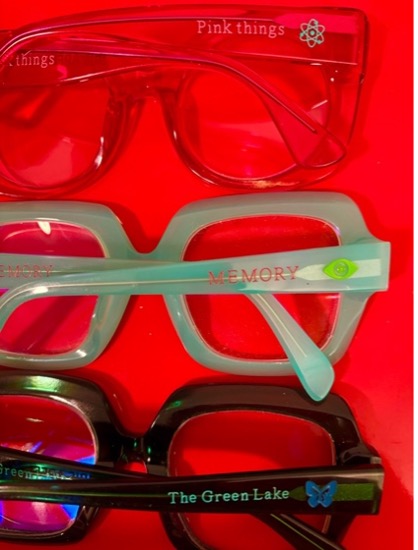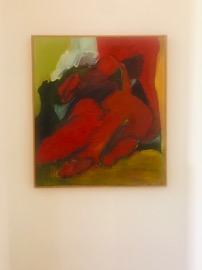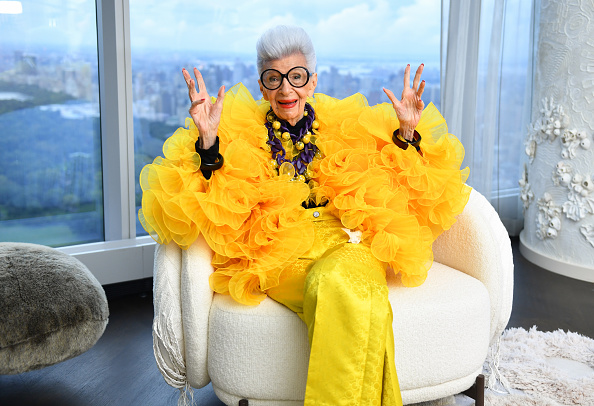Iris Apfel sits for a portrait during her hundredth-birthday party at Central Park Tower on September 9, 2021, in New York City. Photograph by Noam Galai/Getty Images for Central Park Tower.
Against the backdrop of a cold white room, Iris Apfel’s yellow outfit, which she wore on the occasion of her hundredth birthday, sings its own joyous song. Both here and elsewhere, Apfel, an artist and fashion designer, often paired gorgeous things sensually by color and texture, rather than by invoking some obvious theory or idea. She was not afraid to wear a yellow tulle coat with yellow silk pants (which she designed herself in collaboration with H&M). She celebrated yellow vivaciously; she took up space with yellow. With her arms raised in this picture, she looks like some sort of bishop or religious figure. Her open palms throw spectral glitter upon us. A spiritual icon. Just by looking at her, I feel her upturned palms manifesting my dreams.
Apfel famously said: “More is more and less is a bore.” This statement was in conversation with Coco Chanel’s equally famous fashion advice: “Before you leave the house, look in the mirror and remove one accessory.” Apfel’s embrace of “more” surely was a celebration of life itself.
Apfel passed away in 2024. With her passing, she took away from this world a joy in everyday living and a view of the self through the lens of quotidian but bombastic fashion. She emboldened others to embrace their truest selves. Her looks asked us to dress not to gain the acceptance of others, but to be guided instead by our own visions. Her outfits combined items from high and low culture and seemingly unrelated accessories that coexist through poetic connections, all within the spirit of abundance.
My mother, Carole Lasky—an artist, art historian, art collector, and professor—passed away in 2024 as well. My life and style are forever in homage to her. My mother taught me that everyday life demands adornment, and that each day your aesthetic choices become important costumes of the self. Like Apfel, my mother worshipped abundance. She saw a sort of spiritual freedom in always embracing more. When I was a newborn baby, one of the first things she said to me was “We will have fun in this life—we will go shopping!”
And we did have fun. When I was growing up, we would go to flea markets together almost every weekend, always in search of the find that we might add to an existing collection or that might start a new one. The space of a flea market was an important classroom for me, especially as a young poet. It led me to an expansive understanding of what art could be. It taught me to resist what has already been deemed “good” art, and a formulaic sense of aesthetics. The chaotic space filled with vintage clothes and objects taught me to trust my own vision of what was beautiful.
In 2008, I wrote a poem called “Style Is Joy,” in response to a review of my first book, AWE, which stated that my poetry was all style and nothing more.
Even then, I thought: So what’s the problem with that? For a long time, I have embraced a poetics that endlessly blossoms, and a “more is more” kind of ethos when it comes to creativity. Over the years, as friends and lovers have told me to slow down–to stop writing so much, to stop collecting strange things, to stop my over-the-top expression–I have gone in another direction. For me, the act of creativity is not something to dole out in tiny crumbs. My mother taught me that creativity is endlessly generative and generous. And holy.
***
An all-turquoise look Apfel donned as part of a 2021 campaign for Zenni Optical has always been a favorite of mine. Apfel takes the basic power of monochrome and changes the world around her. She piles on bangles, necklaces, a faux-fur coat, and sunglasses, all in a blinding hue of David Hockney pool blue. Her nails and lips provide an accented tension in their complementary red, but the emphasis is on the electric turquoise and how its frequency brings the whole thing together. Texture and shape become interconnected by the high voltage of a love affair between blue and green.
Looking at her outfit, I think of the work of Louise Nevelson, whom I learned about as a child while sitting in my mother’s art history classes. Nevelson’s sculptures often marry disparate objects through a single color. Nevelson’s work reminds us how color makes a mood that can wash over anything, like the muted gold of her sculpture Royal Tide II, dated 1961–1963. In the sculpture, what might have been a wheel, a pipe, or other random household object is synthesized with the power of gold. There is a cohesion to form that is created in the monochrome, where the specific uses of each item are washed away. And yet the abstracted shapes, once everyday things, become more special within their golden symphony.
One thing I’ve always loved about Apfel’s outfits is that she seems to be trying to emulate a bird, or perhaps even a mythical creature. In a 2022 photo by Ruvén Afanador, she is birdlike and regal in a gold-and-black Giambattista Valli gown. Her golden necklace looks more like feathers than metal, spilling out from her neck. Her large gold bangles are armor or brass instruments, ready to herald a new day. There is something regal even to her pose, with her graceful, hot red fingernails upon her cheek, framing her face and iconic black eyeglasses. Her gown falls out of the frame, suggesting that the magic of a good costume is infinite.
The Afanador portrait of Apfel reminds me of portraits of Queen Elizabeth I. Although, in depictions of her, I suppose there are no Iris Apfel glasses. Instead she sits in her sixteenth-century attire, her ruffled collar fanned out under her chin like a glamorous and lacy king cobra. Her gown emptying out of the frame of her portraits, stretching into an endlessness.
***
My mother told me that if you want to be an icon, you should pick one distinct thing to wear and keep wearing it. For Apfel, that must have been glasses. Glasses were always important to Apfel. All you need to see are her legendary large frames to know that an illustration is meant to signify her. In a 2022 W Magazine interview, she described collecting “interesting spectacles” in a box when she was very young. For Zenni Optical, Apfel designed a series of her glasses as affordable frames. I myself own several pairs, a few of which can be seen in the photo below.

Photograph courtesy of Dorothea Lasky.
Zenni has a cool service where, if you have an online account, they will do engravings for free up to a certain character limit. On the glasses above I engraved titles of books I’m working on or parts of poems, so that I can absorb the energy as I’m writing. As I write this, I am wearing the ones engraved with “The Green Lake,” which is the title of a book of poems I’ve just finished. It’s wonderful to wear glasses that Apfel herself designed. It’s as if I am able to see the world through her eyes.
***

Photograph courtesy of Dorothea Lasky.
Above is one of my mother’s paintings, likely done in the early seventies. I recently found out she titled it Red Things, which I had never known while she was alive. I saw the title written in the sweeping strokes of her familiar signature as I was moving it to a more permanent place in my apartment. Her title resonates with my poem titles, which often focus on simple and brutish descriptions of objects. It also reminds me of Sylvia Plath’s “pink things” from her poem “Fever 103°” (the same phrase engraved on my Apfel Zenni glasses above). In Plath’s poem, the line reads: “By whatever these pink things mean!” For me, “Fever 103°” has always been about the dissolution of ego in the afterlife. Perhaps the only eternal truth about existence is a grappling with the presence of things.
I’ll never get to ask my mother directly what moved her to call the painting Red Things. Maybe it was simply a celebration of the color red and the spirit infused in things that find themselves in the frequency of that color. An homage to the idea that “art is what is,” as she might say.
I’m not sure what the purpose of life is. Perhaps it is to be creative. That’s what I keep coming back to, at least.
Mother, as I venture through the uncharted waters of life now without you, I’ll think of the divinity of red things and their endlessly generative power. In your honor, I’ll try to think of more, not less.
Dorothea Lasky is the author of several books of poetry and prose, including the forthcoming MEMORY (Semiotext(e)).

